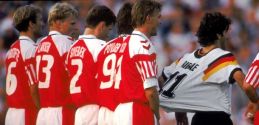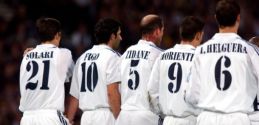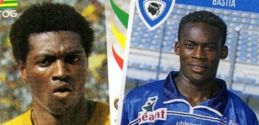A guide to the 2011 Copa America: Part Six – The Giants, Argentina and Brazil
The final part of David N’s guide to the Copa America is about as comprehensive as it gets and it’s brilliant to boot.
In South America, despite the qualities of Uruguay, Chile and Paraguay, there really is a “Big Two”, and then there’s everybody else. Argentina and Brazil have bigger, more successful clubs, produce and export more players, and more regularly compete at World Cups than any of their continental rivals. A look at some of the players left out of their squads reveals a roster who would walk into any other starting XI in South America: Hulk, Ronaldinho, Lisandro Lopez, Javier Saviola, Luis Fabiano, Lucho Gonzalez, Marcello, Diego, Juan Pablo Aimar, Andreas D’allesandro, Alex, Nicolas Otamendi, Nilmar, Kaka, Julio Baptista.
There are many others. This depth of quality is unmatched anywhere else in the world. The last two Copa America finals have been Brazil vs. Argentina, and it is extremely likely that this one will be too.
ARGENTINA
Argentina have not won a senior International title since the 1993 Copa America, a staggeringly long trophy-drought when the quality of players and teams produced in the interim is considered.
Not only that, for the cliches are true: football is like religion in Argentina, part of the fabric of everyday life, always on TV, in the papers, in peoples conversations. For thousands of tourists in Buenos Aires - arguably the greatest football city on earth, with dozens of clubs and decades of rich, beautiful history - a trip to see Boca Juniors or River Plate is a big part of being in Argentina. Domestic clubs are still successful in South America: Estudiantes won the Copa Libertadores in 2009, while Independiente won the Copa Sudamerica last year, but the national team, for all its stars, its lovely football and its air of football royalty, needs to win a trophy.
There have been plenty in the past: two World Cups, at home in 1978 for Cesar Menotti’s pure example of short-passing attacking Argentine football led by Mario Kempes and Daniel Passarella, and in Mexico in 1986 when Diego Maradona declared himself possibly the greatest player of all time by dragging Carlos Bilardo’s side to the title. There have been 14 Copa America titles, mostly from the 1920s to the 50s, with 1991 and 1993 the most recent successes. Add to that a couple of recent Olympic titles for the Under-23 squads (with three senior players in each tournament) in 2004 and 2008, and you have an undoubted football superpower in need of some silverware.
And Argentina have come close in the last decade. Losing the last two finals to Brazil says something about the volatile football chemistry between the two nations, and about a recent Argentinean inferiority complex. In Peru in 2004, Marcelo Bielsa’s side dominated much of the game and led approaching the final whistle before a last ditch Adriano goal sent the match to penalties where Andreas D’allessandro and Gabriel Heinze missed the first two kicks, the Brazilians missed none, and Argentina went home empty-handed. In 2007, Alfio Basile’s side played some sparkling tiki-tiki (the Argentinean equivalent of tiki-taka) football, manipulated by the genius of Juan Roman Riquelme all the way to the final, where Dunga’s brusquely antifutbol second-string side kicked and counter-attacked them out of the tournament on the end of a humiliating 3-0 scoreline.
More or less that same team, but managed by Jose Pekarman, had played the best football of the 2006 World Cup in Germany - everybody will remember their six goal demolition of Serbia & Montenegro and more particularly Esteban Cambiasso’s immortal goal from that game - only to lose out on penalties to an average German side in the quarter-finals after Pekarman lost his nerve and substituted a dominant Riquelme with Argentina in control and in front. Then came Maradona’s farcical spell in charge which included a row with Riquelme, dozens of players called up for pointless friendlies and ultimately another World Cup quarter-final exit at the hands of Germany. Only this defeat was a harrowing and deserved 4-0, with Maradona’s tactics and selection both criticised in the aftermath.
Maradona is gone, replaced by his old teammate from 1986 and 1990, Sergio Batista. Batista enjoyed success as coach of Argentina’s youth sides, leading the Under-23s - a side including Riquelme and Javier Mascherano as overage players - to that 2008 Olympic Gold, and took over the senior side full-time after his brief spell as caretaker was judged a success, containing as it did a notable and stylish 4-1 spanking of world champions Spain. He knows many of the young players in the squad from the youth teams, but despite the incredible depth of talent at his disposal, he has inherited a few significant problems from Maradona’s spell at the helm.
Chief amongst those problems is how to get the best from Lionel Messi (top). He is regarded differently in Argentina, where his move to Barcelona as a boy makes him a “Catalan” and the fact that he never played for an Argentinean club is seen as almost suspicious. He is not popular in the same way that Carlos Tevez, Boca Juniors icon and man of the people, is, for instance. But his immense talent is undeniable, and the national team needs to serve and harness it in the same way Barcelona do if they are to achieve anything in this tournament. Batista’s predecessors took different routes with Messi. Both Pekarman and Basile had to accommodate him alongside Riquelme, so he was kept out on the wing with the Boca Juniors playmaker as the number ten, in the centre. Batista did something similar when he had both at the Olympics, although Messi was encouraged to wander infield more and link up with Riquelme, with successful results. Maradona preferred a 4-4-2 with Messi at the tip of a midfield diamond, in what had been Riquelme’s role as the enganche. However his other selections sabotaged his own formation, leaving “la pulga” isolated and frustrated in difficult games, especially that 4-0 defeat to a rampant Germany.
Batista instead opts for a 4-3-3 and deploys Messi as a “false nine,” front and centre of the attack, where he can do most damage. That way he is close to the penalty area and ready for one of his little surging runs or to link with a teammate, but also free to drop deeper and drag defenders with him in search of the ball. With his ability to create chances from nothing, he is likely to add to the 16 goals he has scored in his 56 caps.
On the flanks Batista seems to have settled on Ezequiel Lavezzi of Napoli and Angel DiMaria of Real Madrid, both pacy, direct and goal-hungry young players who can beat a full-back and seem to understand Messi and his methods. But the Argentine bench is fully stocked with forwards, including Tevez, Gonzalo Higuain, Diego Milito and Sergio Aguero, each of whom offers something slightly different to the team, from Tevez’s energy and incisive dribbling, Higuain’s aerial ability and movement, Milito’s strength at holding the ball up to Aguero’s intelligence and sublime technique in front of goal. If the team can get the ball to these attacking players, Argentina will score goals.
But getting the ball to them is not as simple as it sounds, since Batista favours the solidity provided by three defensive midfielders, relying on Messi to link, create and finish.
That midfield is built around the solid base provided by Mascherano. For my money the best holding player in the world, he remains terrifically aggressive in his hustling and tackling, positionally disciplined, and calm and precise in his distribution. A first season with all-conquering Barcelona can only benefit Argentina, as it has seen the national team’s captain play as centre-half and learn to alter his duties in his own position when he replaced Sergio Busquets in defensive midfield. In South Africa he frequently found himself overrun in the middle of the pitch and even he struggled to cope, a struggle that defeated him against Germany. That was down to the players Maradona put around him: while Juan Sebastian Veron controls possession, his mobility is significantly reduced from his more athletic pomp, and when he was dropped Mascherano found Maxi Rodriguez and DiMaria beside him in midfield. Both fine players, but neither particularly strong defensively, their attacking forays left huge gaps for Germany and Mexico to play into.
Batista plays Valencia’s hugely talented Ever Banega (above) as his most advanced defensive midfielder, while Esteban Cambiasso of Inter Milan seems to be his first choice for the other midfield spot. Banega is an all-rounder, emerging in the number five role at Boca Juniors in his teens, but capable of playing further forward. His passing is superb - he will probably have more of the ball than anybody else in Argentina’s games, always open, always varying his touches, allowing the team to play everything through him, rarely giving it away, capable of some silken football and always looking to link up with the forwards - but he is a willing runner too, defending and tracking back remorselessly through games. His interplay with Messi in recent games has been lovely to behold. Cambiasso is similar in workrate and ability to retain possession but perhaps slightly more defensive in outlook, and together with Mascherano they are a formidable unit.
If Batista needs to, the more creative option of Javier Pastore (below) waits in reserve. The Palermo star is the closest thing the squad has to a classic Argentinian playmaker, and his pace and trickery, allied with the passing ability of Banega and Messi’s genius, seem a mouth-watering prospect, albeit one we may only see if Batista gets desperate.
Fernando Gago of Real Madrid and Anderlecht’s Lucas Biglia, both hard-working and technically sound defensive midfielders, are instead the most likely replacements for any of the first choice midfield trio, with Diego Valeri of Lanus and Enzo Perez, just sold by Estudiantes to Benfica, being the two more attacking options who were excluded when squad was cut from 26 to 23.
Defence has long been where Argentina have had problems, which accounts for Batista favouring such a solid midfield. Lacking an outstanding centre-half in the absence of the injured Walter Samuel, Batista has generally opted for experience over some promising youngsters. Spartak Moscow’s Nicolás Pareja will start if recovered from injury, but if not the central defenders will probably be Nicolas Burdisso of Roma and Barcelona’s Gabriel Milito. Both 30, and with 78 caps between them, they are good readers of the game, solid in the air, strong in the tackle and comfortable playing the ball out of defence. Neither is particularly quick, and the danger is that the likes of Neymar and Falcao could panic this defence with pure pace.
There is a similar situation on the right side where the legendary Javier Zanetti will drag his 38 year old frame up and down the wing all tournament, creating chances, providing leadership and setting an example as he adds to his 141 caps. His weakness is also pace, a problem in a fullback, even one as experienced and wily as “Pupi”. Young Marcos Rojo of Spartak is the most likely to take the left back slot, and he is fast enough over the ground, adventurous in attack and level-headed enough to suggest that the problems will more likely emanate from the other areas of defence, unless anyone can exploit his relative inexperience. Pablo Zabaleta of Manchester City can replace either fullback with equal efficiency and steel, and AZ’s Sergio Romero has grown into his role as First choice in goal.
Argentina, then, go into the tournament as favourites, based on the presumption of home advantage and the quality of their squad. They will probably play some scintillating football, score many goals and make it to the later stages. But their defensive inadequacies may tell when they face the tougher opposition, and even the firepower they have upfront might not be enough to compensate. The pressure of playing in Argentina before expectant crowds could also affect them in a negative way.
However, they do possess some sparkling talents, and the young man who is currently the best player in the world and already one of the greatest of all time.
They can, undoubtedly, with this competition. It should be fascinating to see if they do.
BRAZIL
By way of contrast, Brazil expect to win it. They aren’t even taking it all that seriously, partly viewing it as preparation for the World Cup they will be hosting - and under incredible pressure to win - in 2014.
That Brazil is the world’s greatest football nation seems beyond dispute. They have won the World Cup five times - in 1958 and 1962 with the generation of Garrincha and Pele, most gloriously in 1970 when Pele was joined by the likes of Jarzinho, Carlos Alberto and Rivelino, then again after a long and painful drought in 1994, marshalled by Dunga and spurred by Romario, and most recently in 2002, with starring roles for the three Rs: Ronaldo, Rivaldo and Ronaldinho. Those winning sides are joined in the Brazilian hall of fame by Tele Santana’s legendary 1982 team, who, with the likes of Zico, Socrates, Falcao, Cerezo and Eder, played unbelievable football and won nothing. They have won the Copa America eight times, but four of those have come since 1997, in 1999, 2004 and 2007, showing the way Brazil have become the dominant power on the continent.
That is fitting; Brazil is the biggest country in South America, with a massive population of 190 million, and a growing, wealthy economy. The Brazilian league reflects that: newly prosperous, its many mega-clubs, such as Flamengo, Corinthians, Sao Paolo, Internacional and Santos, have recently begun to assert their dominance in the Copa Libertadores, and Brazilian players - including Ronaldinho, Fred (below), Elano and Luis Fabiano - have started to leave European giants to return home, lured by once-unthinkable comparable wages.
The national team should be thriving, too. But the Dunga era was a strange one for Brazil. Facing constant criticism for the style of play he chose, Dunga was nevertheless a successful coach. His side won the 2007 Copa and the Confederations Cup in 2009 but choked when faced with an organised, determined Holland in South Africa. What was wrong with Dunga’s style? Nothing; his team were beautifully balanced, lethal on the counter, and defensively formidable. But in an era when the world expects Brazil to play the “beautiful game”, where we have been sold “joga bonito” by Nike, where images of 1970 and 1982 dominate our expectations of the team, his insistence on proritising defensive solidity over attacking flair disappointed many. Only winning the World Cup would justify his methods, and his failure to do that saw him replaced by Mano Menezes.
Menezes has enjoyed recent success at club level in Brazil with Gremio and Corinthians, displaying a fine way with big egos, a pleasingly adventurous style and a great manner with the press. He also believes in youth, bringing through both Anderson and Lucas Leiva while he was at Gremio, and planning to found his attack on young talent. The first choice front three in a loose 4-3-3 would be Alexandre Pato and Robinho of Milan alongside Santos’ Neymar. All three are incredibly quick, each can dribble and create their own chances, and they are all fine finishers. Pato will be the most central, with Neymar (held aloft by Ganso below) and Robinho cutting in from the flanks and the three expected to interchange fluidly. Fred, once of Lyon, now back home with Brazilian champions Fluminense, is the only other striker in the squad, though Shaktar Donetsk’s Jadson, usually an offensive midfielder, can also play in the forward positions if there is need.
Presently Neymar is the rising talent, with big European clubs chasing his signature, and a crucial goal in Santos’ recent Copa Libertadores final triumph to his name and three goals in his three games for the national team. He undoubtedly possesses great talent, exhilarating with the ball at his feet anywhere around the area, but his temperament is questionable; a tendency to dive at the slightest contact and react to the smallest provocation can affect his application in big games, something the cynical, experienced defenders in opposition squads will have noted with great interest.
Just as exciting as Neymar, and without the question-marks about his attitude, is his Santos teammate Paulo Henrique Ganso (giving a piggyback to Neymar above). Something of a throwback to Brazilian playmakers of earlier eras - the likes of Rai and Falcao spring to mind, though he reminds me most of the Argentine Riquelme, only with more pace - Ganso is all elegance and luscious passing play. A measure of his talent and potential is the general willingness in Brazil to entrust the team’s attacking to him following an era when playmakers weren’t given the benefit of any doubt for Brazil. Only Kaka has regularly claimed the berth between midfield and attack, and that is likely down to his coruscating pace. Ronaldinho was generally out on the wing, and Alex and Diego have barely featured at all.
The big doubt with Ganso is his susceptibility to injury. He has had problems regularly over the last year, and only returned from a few weeks out for the second leg of the Libertadores final, where he played a crucial role, orchestrating much of Santos’ attacking play. He knows how to get the best out of Neymar, as does the player most likely to benefit if he is injured. Elano, now back in Brazil with Santos after his spell in Europe, is a versatile attacking midfielder, excellent at set-pieces and, with 46 caps, extremely experienced by the standards of this youthful Brazil squad.
The other options for the attacking role in midfield are the aforementioned Jadson (below), a revelation with Shaktar, and Lucas Moura, the 18 year old Sao Paolo livewire, whose squat frame allows him to launch devastating runs at back-pedaling defenders and whose vision creates chances for his teammates.
One of the controversies of the selections for Brazil’s squad was the exclusion of Lazio’s tremendous midfielder Hernanes. For the Roman club, he plays virtually as a number ten, and his creativity made him probably their player of the season as they maintained an improbable title challenge right up to the last weeks of Serie A. But his position for Sao Paolo in Brazil had been as a deep-lying regista, and many hoped he could play in that role for the national team, perhaps with a more disciplined holder alongside. A disastrous red card for a high foot in a recent friendly with France ruined his big moment, and Menezes has instead decided on two orthodox screening players in midfield.
The first choice players in these positions will be familiar to English fans; Liverpool’s Lucas Leiva and Ramires of Chelsea. Lucas is more defensively disciplined for his country while Ramires breaks forward, having scored two goals in his 21 caps. But both have the pace, strength and intelligence to perform in that area. They are a more technically proficient, talented pairing than the players preferred in those positions by Dunga - generally the ageing Gilberto Silva and Felipe Melo - reflecting Menezes belief in playing football all over the pitch.
Tellingly, the area of the team he has altered least was Dunga’s strongpoint; the defence. Here the two centre-backs come from the Milan clubs: Internazionale’s classy, dependable Lucio, who is Captain, with 97 caps and 33 years. And Milan’s Thiago Silva, a fantastic footballer with both pace and anticipation. Together they present a forbidding, intimidating wall. The alternatives are the more adventurous David Luiz of Chelsea and his old Benfica partner, Luisao. The marauding, unstoppable Dani Alves of Barcelona has claimed right back under Menezes, while Maicon remains in the squad, and Andre Santos, who played for Menezes at Corinthians, now at Fenerbahce, takes the left back spot. They guarantee that Brazil will attack down the flanks relentlessly throughout games and wear opponents out through the variety of the threats they present.
Inter Milan’s Julio Cesar is the first choice goalkeeper, at least until he repeats the error that proved so costly against Holland at the World Cup. But he is a fine player, calm, assured and possessing the kind of aura a great keeper needs, and he will generally be hard to beat in this tournament.
As will his team. Brazil are likely to reach the final; breezing through their group is compulsory - only Paraguay offer a potential problem - and they will expect to get off to a thumping start in their first match against Venezuela. After that, it’s unlikely anyone will stop them until they meet Uruguay, Chile or Argentina in the later stages. The Uruguayans in particular love to play Brazil, and have a good record against them.
They should be fascinating to watch, especially if the young guns upfront gel and deliver the sort of football the Brazilian public craves after the Dunga years.
More of David N’s musings on football from South America and beyond can be found on GolGolGolGolGol and also on his Twitter page.
Tags: , , , , , , ,Share this article
Leave a comment
- When did co-commentary become such a serious and miserable business?
- Why do we devote so much time to sharing our love of football for free?
- Villa’s Tokyo downfall: The apparent formality of a world title match
- Son Heung-min and the forgotten wonder goals
- Guess the Premier League goalscorer from the GIF
- A fateful flight
- Goodbye to the instant analogue gratification of Ceefax
- Player Profile: Steve Ogrizovic
- Rejecting FA Cup money in favour of a car boot sale
- It’s a man’s world? Former Arsenal manager crosses the gender divide











